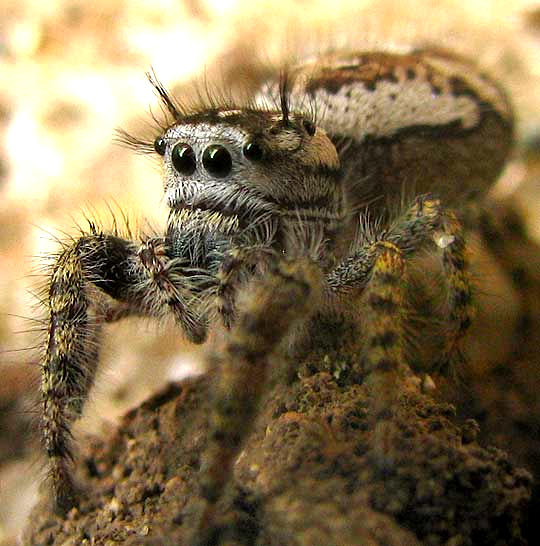The above picture is of a jumping spider, Phidippus arizonensis, fairly common in the understory of oak woodlands in arid parts of the southwestern US and adjacent Mexico. The name "jumping spider" is a general one used for all species in the Jumping Spider Family, the Salticidae, the largest of all spider families, with over 6000 species described worldwide as of 2019. Jumping spiders enjoy some of the best vision of all arthropods, which you'll believe when you see them make huge jumps (for their size) and seem to land exactly where they wish. Mostly they're active during the day, so they're among the most commonly noticed of spider species. As they move about they may anchor or "tether" a filament of silk, the "dragline," to a secure spot, then if something causes the spider to lose its foothold and fall, the spider can pull itself up the dragline and start wandering again. This is the kind of interesting information you can gather when you begin spider watching, identifying, and looking up spider names to see what's known about them.

At the right is a drawing of the face of another commonly occurring kind of spider, that of the wolf spider. The eight red circles are eyes, the pink ovals are the jaws (known technically as chelicerae) and at the very bottom of the two jaws you can barely make out two sharp, horizontal items, and these are the fangs. Notice that a wolf spider's eyes are distributed in a different manner than they are on the above jumping spider.
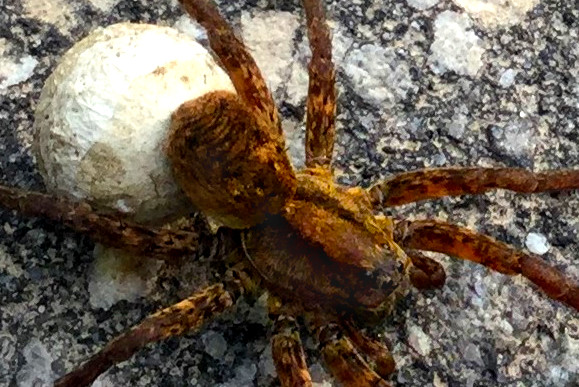
Image © Laura Maskell, Ontario, Canada
Above you see a wolf spider with a white egg sac attached to her rear end. Since Wolf Spiders have no webs, the mothers carry their egg sacs with them as shown. As young spiderlings hatch from the sac they climb onto their mother, who carries them on her back, as shown below:
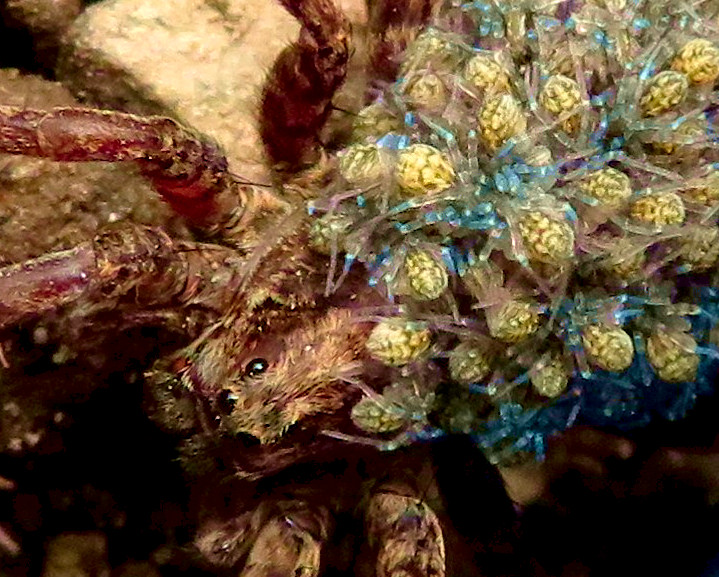
Image © Laura Maskell, Ontario, Canada
Flower spiders sit on flowers waiting for prey to come along, then ambush them and suck their juices out, as is happening above. The Flower Spider shown below can change its ground color at will, helping it blend in with the flowers among which it is hiding. Flower Spiders inject their prey with a potent toxin that disables insects much larger than themselves. Flower Spiders are part of a larger group of non-web-spinning spiders known as Crab Spiders, of which about 130 species are known just in North America. Crab Spiders hold their legs crablike and walk forward, backward or sideways like crabs. Most Crab Spider females guard their egg sacs but die before the eggs hatch.
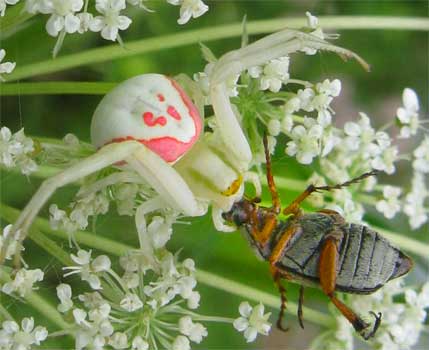
Image by Bea Laporte, Ontario, Canada
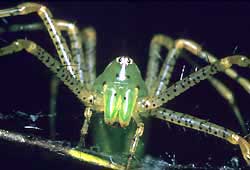 At the right you see a member of the Lynx Spider family, the Oxyopidae. Probably it's the Green Lynx, Peucetia viridans. Lynx spiders, like wolf spiders, hunt prey, but instead of ranging across the ground they specialize in prowling vegetation. All are active during the daytime and with their 8 eyes have good vision. The Green Lynx's body is about 0.6 inch long.
At the right you see a member of the Lynx Spider family, the Oxyopidae. Probably it's the Green Lynx, Peucetia viridans. Lynx spiders, like wolf spiders, hunt prey, but instead of ranging across the ground they specialize in prowling vegetation. All are active during the daytime and with their 8 eyes have good vision. The Green Lynx's body is about 0.6 inch long.
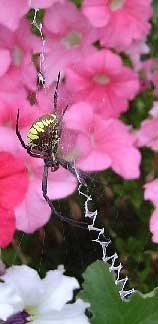 Photo by Elizabeth Kofford in Happy Camp, California
Photo by Elizabeth Kofford in Happy Camp, CaliforniaAt the left is another very common spider, especially conspicuous in late summer and fall because of its large size (body an inch long) and its tendency to construct webs in open places easy to see. This is the Garden Spider, sometimes known as the Black-and-yellow Argiope, Argiope aurantia.
More than one kid has caught a grasshopper and tossed it into this species' web to watch the big spider quickly wrap the grasshopper in a mummy-like cocoon of silk, then bite through the cocoon and begin sucking out the poor grasshopper's juices. One special feature about this species' web is that in the center there's a bright, vertical stripe of zigzagging silk, as shown in the picture. Notice that argiopes hang head-down in their web's center.
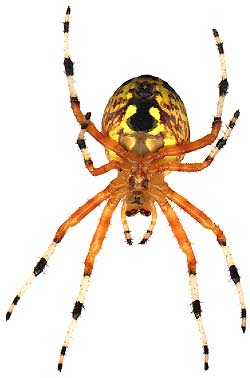 At the right is an unidentified member of the genus Araneus, the largest of all spider genera, with over 1,500 species found in it worldwide. Araneus spiders are medium-size species and their abdomens are often brightly colored. Many species have the little "window" you see in the middle of the underside of this spider's abdomen, and intricate, zigzagging and/or speckled designs on the abdomen's top side. A typical Araneus web would be the classic orb web. The spider, instead of staying in the web's center, may build a retreat in a rolled-up leaf near the web. A "signal line" composed of a special strand of silk connects the web's hub with the leaf and when the spider feels vibrations on the "signal line" the spider rushes out to see if it's caught anything!
At the right is an unidentified member of the genus Araneus, the largest of all spider genera, with over 1,500 species found in it worldwide. Araneus spiders are medium-size species and their abdomens are often brightly colored. Many species have the little "window" you see in the middle of the underside of this spider's abdomen, and intricate, zigzagging and/or speckled designs on the abdomen's top side. A typical Araneus web would be the classic orb web. The spider, instead of staying in the web's center, may build a retreat in a rolled-up leaf near the web. A "signal line" composed of a special strand of silk connects the web's hub with the leaf and when the spider feels vibrations on the "signal line" the spider rushes out to see if it's caught anything!
Well, these are just five randomly chosen species among thousands. I'm telling you about them to whet you appetite. By now I'm hoping that you're convinced that spider study opens up for us a whole new world.
THE VENOMOUS SPIDER PROBLEM
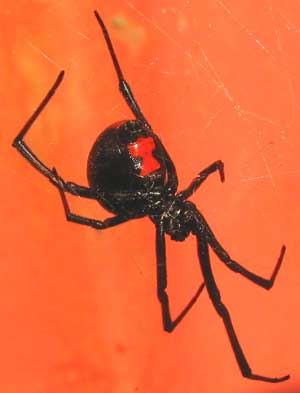
A worrisome thing about spiders is that sometimes they bite. In North America, a few, such as Black Widow shown above and the Brown Recluses, are actually dangerous. In North American backyards, Black Widows might be found beneath pieces of wood or trash lying on the ground. The one at the right was found inside an orange plastic bucket.
Brown Recluses are more often found inside homes, especially on floors behind furniture. In other words, unless your backyard is particularly trashy, you probably don't have to worry too much about any really dangerous spiders.
Moreover, both of these venomous species have striking field marks making them easy to identify. If you acquire a spider field guide the first thing you need to do is to look up these two species, notice the widow's "red hour- glass," and the recluse's "violin," and henceforward keep your distance from spiders with those marks.On the Web you might want to check out DesertUSA.com's Page on Black Widow Spider bites page and its Brown Recluse Spider page.

If spiders can be so dangerous, do they really make good subjects for backyard naturalists? You bet! You just must be a little careful. Look:
SPIDERS AS BACKYARD NEIGHBORS
Wandering around checking out spiders, and paying attention to what you're doing, is certainly less dangerous than hopping into the family car and heading for the local mall. Just follow this one simple rule and you'll have no problem:
SPIDER CLASSIFICATION
Today about 34,000 spider species are recognized. These are sorted into about 100 families, which are sorted into three suborders. Nearly all species found in average backyards belong to just one of those suborders, the Araneomorphae.
To identify spiders often you need to examine obscure features of their anatomy -- especially their mouthparts, spinnerets (silk-producing parts) and leg structure.
Usually when you spot spiders they're perched unmoving in or near their webs, or else they're moving slowly across the ground, and are likely to stop to look up at you if you get onto your elbows and knees to look down at them. You gain nothing by attempting to hold them, so just don't do it.
However, you can draw close enough to get a good view of them, especially if you have a good magnifying glass. In our "Tools" section we say that small hand lenses usually make the best magnifying glasses. Sometimes with spiders the larger, lollypop-type reading lens with a stick handle is more useful, because you can look at them from farther away.
SPIDER WATCHING
COMMON KINDS OF SPIDERS YOU CAN LOOK FOR
Daddy-long-leg Spiders (family Pholcidae)
Cobweb Weavers (family Theridiidae)
Orb Web Spiders (families Araneidae & Tetragnathidae)
Sheetweb Weavers (subfamily Linyphiinae)
Jumping Spiders (family Salticidae)
Crab Spiders (family Thomisidae)
Wolf Spiders (family Lycosidae)
Nursery Web Spiders (family Pisauridae)
Widow Spiders (genus Latrodectus)
Recluse Spiders (genus Loxosceles)
Funnel web Spiders (genera Atraxand Hadronyche, Family Hexathelidae)
How does spider watching compare with, say, bird watching?
For one thing, many more species of spider exist than species of bird. About as many spider species exist just in New York and New England as there are bird species in all of North America north of Mexico. In the US, the little Golden Nature Guide Spiders is great as a first spider-identification book. Using it, I was able to identify the Fishing Spider, Dolomedes triton, pictured below:

Besides books, another approach to identifying spiders is to take a really clear, close-up picture of your unknown species and upload it to the "ID Request" page BugGuide.net
Once you begin looking closely at spiders, one of the most exciting of your first discoveries will be that many, maybe most, are extraordinarily pretty. Even if at first glance they look "small and brown," once you've focused your magnifying glass and are squinting hard, you'll probably see that the body is ornamented with spots, stripes, arabesques, and/or other interesting designs. Many spiders are brightly colored, and some are even shaped like psychedelic witch-doctor masks.
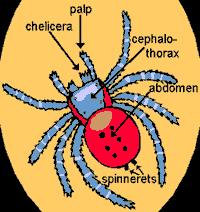
SPIDER ANATOMY & HOW SPIDERS DIFFER FROM INSECTS
Spider bodies are fundamentally different from those of insects. Insect bodies generally are divided into three main parts -- the head, the thorax in the middle, and the abdomen at the end. In spiders, the rear-end abdomen is still there, but the first two segments, the head and thorax, are fused into a single unit referred to as the cephalothorax, cephalo being from a classical Greek root meaning "head."
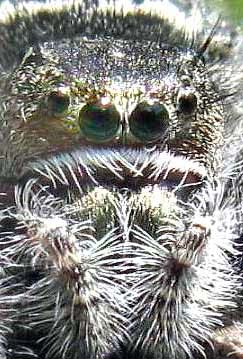 photo of Phidippus purpuratus
photo of Phidippus purpuratusphoto by Bea Laporte
At the cephalothorax's front, note the chelicera, which are fanglike appendages modified for grasping and piercing. These lie between the palps, which help the spider feel things, especially as it moves about and eats prey -- they're "feelers." At the spider's rear end there are tiny spigot-like projections called spinnerets, from which spider silk is extruded. Spiders possess eight legs, in contrast to insects, who possess only six.
Many insects have compound eyes consisting of perhaps hundreds of small eyes, but nearly all spiders just have eight simple eyes. At the left you see a jumping spider, Phidippus purpuratus, with four of its eyes looking right at you. The Jumping Spider Family is one of the largest and most interesting of our spiders. They're active during the day and like sunshine. Instead of producing webs they walk about looking for prey, then jump on their victims when they find them. Before jumping, the spiders fix a silk thread to something stable so that they can climb back to their jumping spot if they miss their prey. This is especially handy when they're hunting in trees! At night and when it's cool they find someplace cozy, maybe in little cocoons or in crevices.
SPIDER EXOSKELETONS
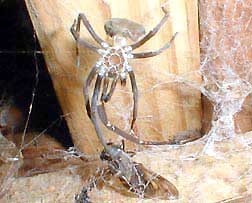 Sometimes you run across something similar to what you see at the right. Looks like a dead spider, right?
Sometimes you run across something similar to what you see at the right. Looks like a dead spider, right?
What it really is, is a spider's discarded exoskeleton, and there's a story behind it.
In a sense, a spider has its skeleton outside its body. The spider's body wall is hardened (the technical term is sclerotized) so that it becomes like a shell over its body. Since spiders don't have bones, the shell serves as the body's skeleton. Because the skeleton is outside the body, it's called an exoskeleton ("exo-" means "outside.")
In our own bodies, muscles are attached to the skeleton's bones. The muscle contracts causing the bone to move, and when the bone moves the flesh around it moves, too. Thus we couldn't walk around without our skeletons. The spider's exoskeleton serves a similar purpose, with the spider's muscles attached to the inner surface of the exoskeleton. A spider's muscle contracts, and the part of the exoskeleton attached to that muscle then moves toward the muscle.
If you think about about having your skeleton on the body's outside instead of the inside, eventually a question will occur to you. That is, "How do spiders grow?"
This is a real problem for spiders and other invertebrates with exoskeletons (insects also have them), and the problem is overcome in a fairly drastic manner. That is, every now and then as the spider grows, it's exoskeleton actually splits open, and an enlarged edition of the spider emerges, leaving the old exoskeleton behind. That's what happened in the photo above. Most spiders split their exoskeletons 4 to 12 times before maturity.
Unfortunately for spiders, it takes a while for a new exoskeleton to harden, and during this time of having a soft exoskeleton the spider is very vulnerable to predators.
Why would Mother Nature cause spiders to have to endure this dangerous time? Surely it's because during most of a spider's life its exoskeleton is of very great benefit, so being vulnerable for a brief period several times in its life is a good trade-off.
SPIDER REPRODUCTION
There's a rainbow of ways that male spiders meet females. Often courtship rituals include dancing and leg-waving. However, the most bizarre part of spider reproduction is that of the spider sex act itself.
The male spider, as is typical among arthropods, possesses nothing like a penis. Therefore, how does the male's sperm enter the female's body? It's with the help of little leg-like appendages at the male spider's head, the palps. Before the male goes searching for a female he deposits a droplet of sperm on a scrap of silk, sucks this into his plunger-like palp, and keeps it handy as he sets off looking for a female. Once he's found his mate and courtship has proceeded satisfactorily, during the mating process the male reaches beneath the female's abdomen with his palp and inserts the sperm through a slit there. From that point, the sperm pass to the eggs more or less as you might expect.
Often you hear that, after mating, the male spider is eaten by the female. That's true in only a few species. However, it is true that in many species, once the male has mated, from nature's point of view he's no longer of value so he forthwith "dies of natural causes."
On the Web take a look at The Arachnology Home Page. Also, there's a site with lots of pictures called Spiders of North-West Europe.

